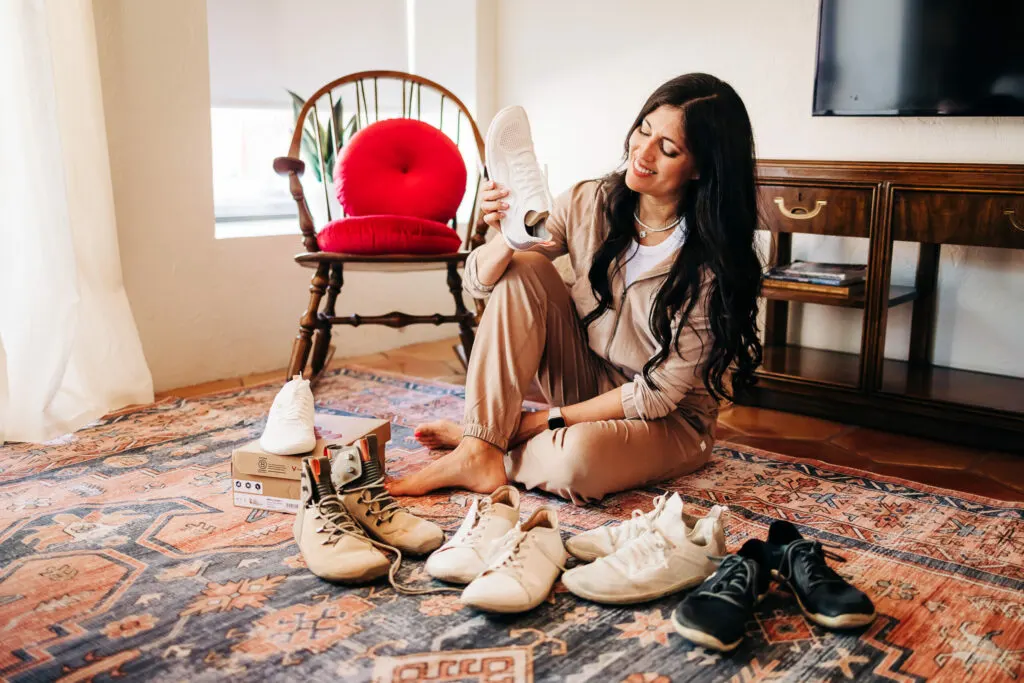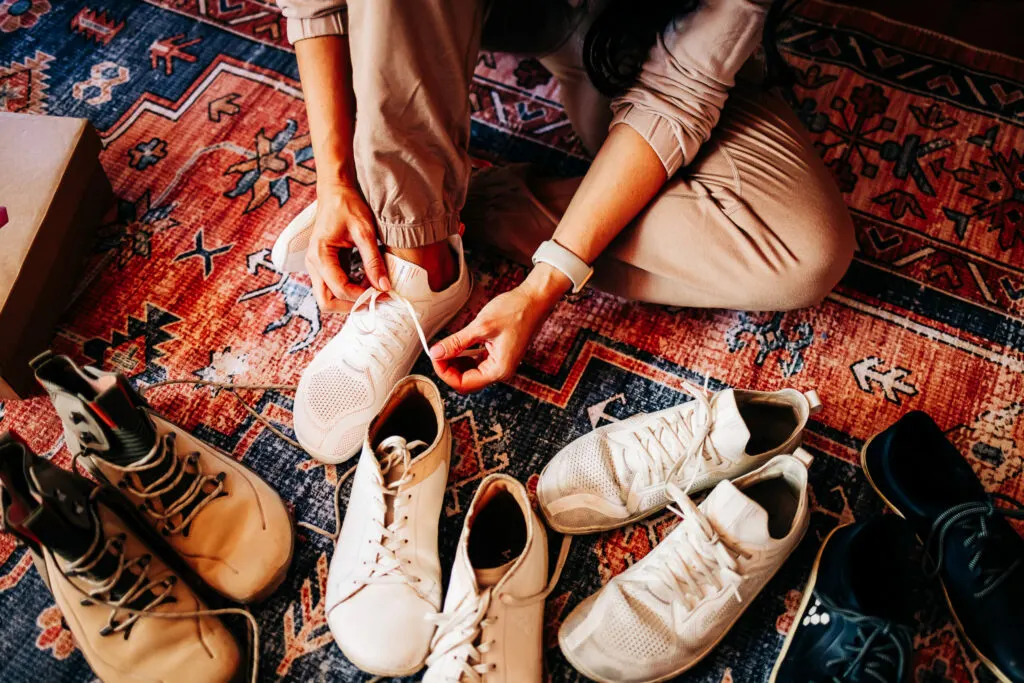
Here’s why I’m obsessed with barefoot shoes and how you can incorporate them into your workout routine and your life!
Hi friends! Happy Monday! How was your weekend? I had a great time in San Diego with Betsy attend the Lagree certification workshop in DEFINE(San Diego friends, go take a class with my friend Carina! I’ve known her for years; we taught barre together in San Diego and she’s an amazing instructor and person.)
So today we’re going to talk about barefoot shoes.

(It was so funny when I went to gather all my shoes for this photo shoot. I thought, Wow! I actually have five pairs and I wear them all and I love them all!)
Barefoot shoes have been around for quite some time.
According This website:
In the 20th century, barefoot shoes emerged as people began to question the need for shoes with cushioning and support. In the 1960s and 1970s, the popularity of the “Jogging” movement led to the development of more minimalist running shoes, which aimed to mimic the barefoot experience.
I think many of us can remember the early 2000s when barefoot shoes made a comeback with the launch of Vibram. I remember the first time I saw them. They looked like duck feet to me. They were hideous, lol. But it was definitely a lightbulb moment. I’ve been working in the fitness industry since 2008, and after multiple trainings and workshops (like the foot stretching and gait classes I took and later taught at Canyon Ranch), I realized the impact footwear has on overall function and how minimalist shoes can change your workouts and your life.
Barefoot shoes are not only lightweight and super comfortable, they allow us to have full function of our foot muscles, full toe extension (instead of our toes being cramped in narrow shoes), and can impact overall posture, alignment, and performance.

Why you should switch to barefoot shoes
What are barefoot shoes?
Barefoot shoes are designed to naturally mimic our bare feet, with the added protection and public regard that comes with having soles. I don’t think many of us want to walk down a dirty street or work out in a gym without real shoes. They have a minimalist design, a low heel (so they don’t have the high cushioning in the back that many running shoes include), thin soles, and wide toe boxes so our toes can breathe and move freely.
The main differences between barefoot shoes and traditional footwear are the heel and toe drop. My barefoot shoes seem very wide compared to my *regular* shoes and sneakers.
Benefits of wearing barefoot shoes
1. Natural alignment of the foot
Think about the position of your feet and how it affects natural posture and foot alignment. Some shoes can cause us to lean forward to maintain balance, throw our pelvis out of alignment, and also affect our gait. It’s unfortunate because they look cute, but heels are some of the worst shoes we can wear for pelvic floor health, posture, and overall function (especially the knees, hips, and ankles).
Barefoot shoes also reduce the chance of bunions, hammertoes, and other foot deformities because the toes are not crushed.
2. Strengthens foot muscles.
Barefoot shoes stimulate muscle work in your feet, ankles, and calves. The thin sole allows you to grip the ground more effectively, which can result in you activating MORE muscles while you live and exercise.
Thin soles result in stronger arches and better stability because the foot has to work to stabilize itself; without the extra cushioning, more muscles can be activated.
3. Improves balance and stability
With barefoot shoes, you can feel the ground more effectively, which improves proprioception, which is the awareness of where our body is in space. Proprioception training is critical to preventing falls, especially as we age.
4. Better posture
Barefoot shoes encourage a natural gait, reducing stress on joints and the spine.
They promote better posture and alignment, which can reduce back pain. Shoes with a lot of cushioning can change the position of the pelvis, which can cause tension in the lower back.
5. Improved sensory feedback
We feel the world through our feet, and barefoot shoes mimic how we would exist in nature, with a greater connection to the ground through thin soles.
With this increased connection, we can have an improved ability to react to uneven terrain.

Who should wear barefoot shoes?
– People who suffer from pain or discomfort in their feet. Of course, consult your doctor first.
– Athletes looking to improve performance and reduce injuries.
– People looking for a more natural and minimalist approach to footwear.
– Anyone interested in strengthening their feet and improving posture.
How to make the transition to barefoot shoes
As much as I’d love to say, “Just put on your new shoes and go!”, there is actually a transition phase. If you’re not used to using all the muscles in your feet, switching to barefoot shoes right away could cause pain. Instead, increase the amount of time you wear your shoes barefoot.
1. Start slow
Start with short walks or low-impact activities. Instead of jumping into running, just walk around the block a couple of times for a few days.
Gradually increase wearing time as your feet adapt, building up to full workouts or full hikes.
2. Perform strengthening exercises
Foot and ankle exercises can strengthen the muscles needed for walking barefoot.
You can also stretch your feet and work on maintaining flexibility to reduce pain. This website has some of my favorite foot stretches.
3. Choose the right surface
Start on soft, even surfaces (e.g. grass or carpet) before progressing to harder terrain.
Alternate between barefoot shoes and regular shoes as you transition.
Frequently Asked Questions About Barefoot Shoes
Are barefoot shoes suitable for running?
They can be, but I definitely don’t recommend running in them at first. Start with walking, then walking with a little bit of running time, and then increasing the running time.
How long does it take to adapt to barefoot shoes?
It took me a couple of weeks. It’s an individual thing.
Can barefoot shoes help with plantar fasciitis?
Yes! I have found that barefoot shoes can improve plantar fasciitis if used gradually and with the addition of foot stretches.
Can I wear barefoot shoes to prevent injuries?
You can use them as part of your injury prevention routine, along with alternating training intensities, rest, stretching, mobility, and good hydration, sleep, and nutrition.
Are barefoot shoes suitable for people with flat feet?
Yes! I am a fellow flat foot sufferer. You may find that by working more muscles in your feet, they are more supported. If you find that your feet sink in or become uncomfortable during the transition, you can add some insoles to provide arch support if that helps.
Where to buy barefoot shoes
There are many brands, but I am loyal to Vivobarefoot. It was the first brand I tried, I loved them and I don’t want to change brands. My referral link gets you 20% off your first pair! (Not affiliated; you will also receive your own referral link when you purchase.) Xeros They are another popular brand that I often see at the gym.
Tips for choosing the right pair for your foot type
I recommend you try a brand and see what you think. Of course, I am a fan of… VivobarefootsGive yourself time to transition and incorporate foot exercises. I hope you enjoy them as much as I do!
Do you wear minimalist shoes? What are your favorite sneakers?
Kisses and hugs
Gina







